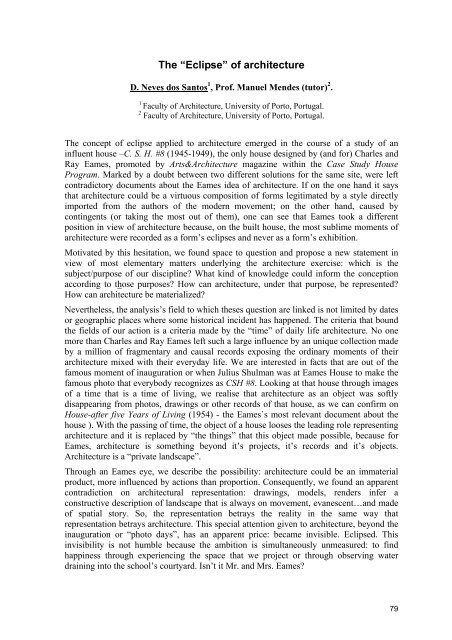IJUP08 - Universidade do Porto
IJUP08 - Universidade do Porto
IJUP08 - Universidade do Porto
- TAGS
- universidade
- porto
- ijup.up.pt
You also want an ePaper? Increase the reach of your titles
YUMPU automatically turns print PDFs into web optimized ePapers that Google loves.
The “Eclipse” of architecture<br />
D. Neves <strong>do</strong>s Santos 1 , Prof. Manuel Mendes (tutor) 2 .<br />
1 Faculty of Architecture, University of <strong>Porto</strong>, Portugal.<br />
2 Faculty of Architecture, University of <strong>Porto</strong>, Portugal.<br />
The concept of eclipse applied to architecture emerged in the course of a study of an<br />
influent house –C. S. H. #8 (1945-1949), the only house designed by (and for) Charles and<br />
Ray Eames, promoted by Arts&Architecture magazine within the Case Study House<br />
Program. Marked by a <strong>do</strong>ubt between two different solutions for the same site, were left<br />
contradictory <strong>do</strong>cuments about the Eames idea of architecture. If on the one hand it says<br />
that architecture could be a virtuous composition of forms legitimated by a style directly<br />
imported from the authors of the modern movement; on the other hand, caused by<br />
contingents (or taking the most out of them), one can see that Eames took a different<br />
position in view of architecture because, on the built house, the most sublime moments of<br />
architecture were recorded as a form’s eclipses and never as a form’s exhibition.<br />
Motivated by this hesitation, we found space to question and propose a new statement in<br />
view of most elementary matters underlying the architecture exercise: which is the<br />
subject/purpose of our discipline? What kind of knowledge could inform the conception<br />
according to those purposes? How can architecture, under that purpose, be represented?<br />
How can architecture be materialized?<br />
Nevertheless, the analysis’s field to which theses question are linked is not limited by dates<br />
or geographic places where some historical incident has happened. The criteria that bound<br />
the fields of our action is a criteria made by the “time” of daily life architecture. No one<br />
more than Charles and Ray Eames left such a large influence by an unique collection made<br />
by a million of fragmentary and causal records exposing the ordinary moments of their<br />
architecture mixed with their everyday life. We are interested in facts that are out of the<br />
famous moment of inauguration or when Julius Shulman was at Eames House to make the<br />
famous photo that everybody recognizes as CSH #8. Looking at that house through images<br />
of a time that is a time of living, we realise that architecture as an object was softly<br />
disappearing from photos, drawings or other records of that house, as we can confirm on<br />
House-after five Years of Living (1954) - the Eames`s most relevant <strong>do</strong>cument about the<br />
house ). With the passing of time, the object of a house looses the leading role representing<br />
architecture and it is replaced by “the things” that this object made possible, because for<br />
Eames, architecture is something beyond it’s projects, it’s records and it’s objects.<br />
Architecture is a “private landscape”.<br />
Through an Eames eye, we describe the possibility: architecture could be an immaterial<br />
product, more influenced by actions than proportion. Consequently, we found an apparent<br />
contradiction on architectural representation: drawings, models, renders infer a<br />
constructive description of landscape that is always on movement, evanescent…and made<br />
of spatial story. So, the representation betrays the reality in the same way that<br />
representation betrays architecture. This special attention given to architecture, beyond the<br />
inauguration or “photo days”, has an apparent price: became invisible. Eclipsed. This<br />
invisibility is not humble because the ambition is simultaneously unmeasured: to find<br />
happiness through experiencing the space that we project or through observing water<br />
draining into the school’s courtyard. Isn’t it Mr. and Mrs. Eames?<br />
79










